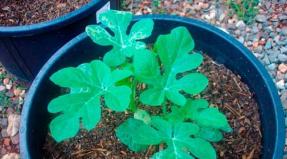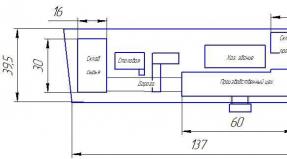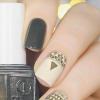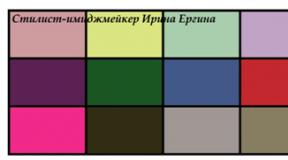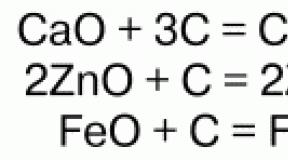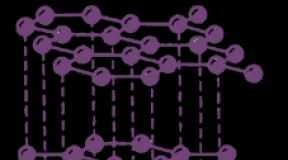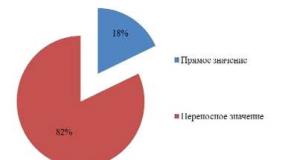Whiteness - poisoning with household chemicals. Whiteness poisoning in humans Whiteness poisoning symptoms and treatment
Whiteness is one of the popular household chemical disinfectants and first aid in the home if something needs to be cleaned.
For many decades, whiteness has been used as a drug to eliminate severe pollution, not only in everyday life, but also in industry. The tool has a low cost, and therefore is popular with most housewives for cleaning plumbing fixtures.
Advantages
- affordable price;
- guarantee of purification from strong pollution;
- preservation of properties at low temperature;
- convenience and ease of use;
- versatility (washing, cleaning, disinfection).
Chlorine is white?
Bleaching powder
Whiteness, like any other household chemical solution, must be handled with care. Specifications say that chlorine and whiteness are one and the same. The composition of the product makes it a strong disinfectant and antiseptic. The main bleaching property is due to sodium hypochlorite - inorganic chemical compound. This element is an oxidizing agent, which contains active chlorine - 95.2%. In case of an overdose, the composition of whiteness can be poisonous, therefore, when using the product, one thing is necessary - to observe simple safety precautions. It is better to use the product in a solution with warm or cold water. The composition of the concentrated product is caustic and, in contact with some materials, may adversely affect their strength. Bleach is applicable only to natural cotton or linen fabrics. The composition of whiteness hopelessly spoils leather, woolen and colored items. It is not recommended to dilute whiteness in water whose temperature exceeds 35 degrees. Just soaking whites in this solution can ruin them.
whiteness poisoning
chemical burn
With illiterate use of whiteness, sodium hypochlorite has a harmful effect on tissues or organs, so in some cases it may be necessary health care. The risk of whiteness poisoning increases in young children if the product is not stored in a special place. Curiosity leads to the fact that the child may inadvertently inhale vapors, pour into the eye or swallow the product.
The chemical composition of whiteness causes severe irritation of the mucous membranes of the nose and eyes, and also has a suffocating effect.
If it gets into the eye without first aid, a person develops a serious chemical burn. Constant contact with whiteness without latex gloves and other hand protection may develop dry skin. After some time, persistent eczema develops, which is difficult to get rid of.
Symptoms
The symptoms of vapor poisoning vary with acute or chronic exposure. In acute poisoning, a single ingestion of a substance in high concentration is observed. Chronic poisoning is common in people who constantly inhale the vapors of whiteness for a long time in small doses. The degrees of poisoning are mild, moderate, severe and fulminant. With a mild form of whiteness poisoning, unpleasant symptoms usually disappear within a day, leaving some discomfort in the lungs of the respiratory tract. One hit of evaporation in the nose or eyes can provoke the appearance of minor changes.
Symptoms of poisoning with hypochlorite vapor are manifested in the form of attacks of suffocation, lacrimation, burning eyes, dry cough and slight pulmonary edema. For severe poisoning, when she breathed in vapors, a short-term cessation of breathing is characteristic.
After this, shallow breathing may resume for a short time. Then convulsions appear, and the person loses consciousness.
If whiteness has entered the body, then with untimely help, death can occur within 30 minutes.
With lightning-fast poisoning, convulsions begin, swelling of the veins in the upper body, involuntary excretion of urine or feces, and instant death. The most severe degrees of poisoning can only occur in industrial conditions, when safety precautions are violated. Whiteness vapor poisoning at home rarely exceeds the average degree.
Work with chlorine
Symptoms of chronic poisoning:
- persistent choking and dry cough;
- deterioration of well-being;
- various diseases respiratory tract;
- periodic convulsions.
Chronic poisoning is typical for workers in the textile and pharmaceutical industries, where there is constant contact with chlorine vapor.
Consequences
Mild and moderate severity of whiteness poisoning through the respiratory tract can provoke the development of many diseases associated with the respiratory system. These include:
- bronchitis;
- pneumonia;
- pneumosclerosis;
- pharyngitis;
- tracheitis;
- emphysema;
- cardiopulmonary insufficiency.
Whiteness in the eye
Chlorine in the eyes
A chlorine-containing agent, if it gets into the eyes, may not harm if they are immediately thoroughly rinsed. In order to avoid negative consequences, it is better to immediately contact an ophthalmologist. In other situations, whiteness can cause serious changes in the conjunctiva. Symptoms of whiteness appear immediately. The first sign is pronounced hyperemia of the sclera. eyeball. Vasodilation in a chemical burn can cause partial loss of vision. The person experiences pain, itching, or burning.
Whiteness in the digestive tract
One poisoning with whiteness in this way in young children can be fatal. Most often, kids are not scared away even by a pungent smell. To avoid this, parents are advised to clean any household chemicals in hard-to-reach places. Serious burns can cause severe pain to a child even with one sip of a concentrated preparation.
Symptoms are expressed in such a clinical picture
- Sharp pain in the mouth from a burn of the mucous membranes
- Bias pain sensation into the esophagus and stomach with irreversible changes in organ tissues
- Hematemesis without relief
- Choking, voice changes
- Urine color change
- Increase in body temperature
- Intoxication
First aid for poisoning
With a mild stage of chlorine vapor poisoning, first aid is to stop working with whiteness. It is necessary to ventilate the room and go out to Fresh air. The throat will be better if rinsed with warm boiled water. Some time it is not recommended to smoke. When a headache occurs due to vapors, it is also recommended to use analgesics.
If you breathed in whiteness, then if you feel discomfort on the mucous membrane, you can drink an emollient for coughing. First aid in case of contact with whiteness in the eye - washing it with plenty of running water and contacting an ophthalmologist. It is forbidden to do various manipulations with the eyes on your own. But if there is Albucid in the medicine cabinet, then it can be used.
When the whiteness got inside, you will need an emergency ambulance. In most cases, a person is prescribed surgery for a severe burn of the mucous membrane of the digestive tract.
Poisoning by various means of household chemicals, unfortunately, is quite common among children. Curious young children explore the world in every possible way, and trying an unknown liquid from an unusual bottle is a normal option for them. This is how poisoning with chlorine-containing whiteness occurs, that is, a disinfectant with a wide scope of use.
The composition of the whiteness and the scope of the solution
Whiteness in its appearance and smell is familiar to every housewife. This inexpensive remedy used for various purposes. With its use, you can bring white linen to an ideal state and remove unwanted stains. A solution of whiteness is used to disinfect sanitary devices, it is easy to clean with it.  crockery and tiles.
crockery and tiles.
That is, finding a use for a solution with the smell of chlorine, even with the current level of development of the chemical industry, is not difficult. Housewives often choose this product also due to its well-known antimicrobial properties, that is, whiteness can cope with various types of bacteria and viruses and thus helps to keep the house clean.
The composition of the whiteness is represented by sodium hypochlorite, it is a strong oxidizing agent and contains active chlorine.
Poisoning with bleach solution
Anyone can be poisoned by whiteness. When cleaning or bleaching linen, poisoning occurs when chlorine vapor is inhaled, which adversely affects the respiratory system. 
Careless handling of bleach can also lead to its contact with the mucous membrane of the eyes, sometimes causing the most negative changes in the conjunctiva. Even its pungent smell does not stop small children from taking samples from an unknown solution, and therefore a sip of whiteness can easily get into their stomach. At the same time, symptoms of poisoning with caustic substances develop, and recovery from such a tragedy depends on how quickly the right help is provided at this stage.
Poisoning with concentrated whiteness can also occur in those enterprises where this solution is used as disinfectant. This is mainly due to non-compliance with safety regulations.
Signs of poisoning
 The symptoms of acute whiteness poisoning depend on which organ has been affected by the agent. Most often, the respiratory system suffers from inhalation of concentrated chlorine vapors, while poisoning is expressed by a sore throat, dry mucous membranes, a sharp, painful cough, and a severe headache.
The symptoms of acute whiteness poisoning depend on which organ has been affected by the agent. Most often, the respiratory system suffers from inhalation of concentrated chlorine vapors, while poisoning is expressed by a sore throat, dry mucous membranes, a sharp, painful cough, and a severe headache.
Vapors of whiteness, together with the respiratory system, negatively affect the mucous membrane of the eye, while the conjunctiva turns red, lacrimation, pain, itching appear. With direct contact with whiteness in the eyes, a chemical burn occurs and partial or complete loss of vision is possible. The bleach solution also negatively affects the skin, if you use undiluted sodium hypochlorite without gloves, then irritation, redness occurs, and subsequently dermatitis.
Serious and difficult to treat symptoms and signs of whiteness poisoning occur if this solution is drunk undiluted. It only takes one sip of bleach to cause serious burns. internal organs starting from the oral cavity. Similar poisoning is expressed by the following clinical picture:

Help for acute poisoning with a solution of whiteness should be provided immediately. The life of an injured person depends precisely on how quickly he receives qualified assistance.
First aid and basic treatment
 In case of inhalation poisoning, that is, when whiteness vapor is inhaled, it is necessary to leave the room where the liquid was spilled. It is advisable to go out into the fresh air or carefully check the apartment. It is necessary to rinse the throat well and repeatedly and rinse the eyes with running water. Helps to cope with an overdose of milk, it is recommended to drink it periodically.
In case of inhalation poisoning, that is, when whiteness vapor is inhaled, it is necessary to leave the room where the liquid was spilled. It is advisable to go out into the fresh air or carefully check the apartment. It is necessary to rinse the throat well and repeatedly and rinse the eyes with running water. Helps to cope with an overdose of milk, it is recommended to drink it periodically.
Additionally, you can breathe over soda vapor or inhale oxygen from an oxygen bag. Further, symptomatic treatment is carried out, that is, for headaches, it is necessary to use analgesics, for dryness in the throat, emollients are given.
If whiteness gets into the eyes, they should be thoroughly rinsed with water for at least 10 minutes. After that, 2 drops of a 2% solution of Novocaine are instilled into the conjunctival sac, after 15 minutes Albucid should be instilled. The whiteness solution is washed off from the hands with plenty of water, after which a 5% solution of acetic acid can be used as lotions.
If whiteness is swallowed, it is necessary to wash the stomach and induce vomiting. It is best to rinse with milk or water with the addition of several proteins from fresh eggs. Ambulance should be called immediately, in a hospital for the treatment of poisoning, the antidote Sodium thiosulfate is used.
Household poisoning with Whiteness, among other intoxications, cannot be called frequent, but such cases do happen. And this means that it is better to know about them in advance and take all measures to prevent such a situation.
Whiteness - antiseptic, disinfectant, bleach, stain remover, strong oxidizing agent with a pungent odor. This product contains alkaline components, surfactants and the main components - sodium hypochlorite and active chlorine (up to 95.2% of the total mass).
Whiteness is used in everyday life for various purposes:
- for cleaning dishes or tiles;
- to remove stains;
- as a bleaching agent;
- for disinfection during cleaning.
The popularity of Whiteness is explained by its significant advantages: versatility, low cost, economy and efficiency. Among the minuses is the likelihood of poisoning with this remedy.
By international classification diseases (ICD 10) poisoning with Whiteness corresponds to code T 54.9.
Causes and ways of poisoning
You can get poisoned in 3 ways:

- As a result of inhalation of vapors (if the product is used in an unventilated area).
- In case of accidental or intentional ingestion (accidentally, Whiteness can be children in whose hands this remedy turned out to be, and intentionally - mentally unstable people with suicidal tendencies).
- If undiluted high concentrations come into contact with the skin or mucous membranes, resulting in a severe chemical burn.
Thus, poisoning with sodium hypochlorite in most cases is possible due to non-compliance with the rules for handling this agent.
How poisoning manifests itself
Intoxication can occur in acute or chronic form.
chronic poisoning

This form can develop if a person is forced to constantly, but little by little, contact with Whiteness. This can happen to employees of cleaning companies who are forced to work with such tools on duty. Particularly scrupulous housewives, fanatically washing the house in order to give it perfect cleanliness and to fight infections, are also at this risk group.
Chronic intoxication in pairs is accompanied by the following symptoms:
- frequent headaches, sometimes dizziness;
- persistent dry cough or its attacks;
- nausea, sometimes vomiting;
- development of diseases of the respiratory system;
- rarely, but there are convulsions.
These signs of poisoning are manifested by constant inhalation of chlorine vapors of Whiteness.
Acute poisoning
This form develops after a single severe poisoning, its symptoms increase rapidly. The clinical picture here will be different depending on the stage of intoxication and on the way Whiteness enters the body.
There are four stages acute form Whiteness poisoning through the respiratory tract:

- Light. In a poisoned person, it tickles in the throat, burns the eyes, and lacrimation increases. The person sneezes heavily and frequently. The symptoms go away on their own within a day. This stage leaves no consequences.
- Average. To the same symptoms, a severe dry cough, tightness in the chest and throat is added, and mild pulmonary edema may develop.
- Heavy. To all the signs of the first two stages, a short-term cessation of breathing is added, followed by its restoration, but with obvious difficulties and disorders.
- Lightning. In a poisoned person, convulsions begin, defecation and urination may involuntarily occur, veins in the upper half of the body swell. In the absence of assistance in this case, the death of the victim occurs.
Read also: Headache due to poisoning
If there was a very strong poisoning with high concentrations of Whiteness vapors, death can occur in just 30 minutes.
Most often, at home, intoxication is mild, but this does not mean that you can leave everything as it is.

If Whiteness gets into the eyes, the person's sclera will turn red, the eyelids and eyes will itch, and an increasing burning sensation will begin. With a large amount of the drug, acute pain will occur and desire close or squint your eyes, which is strictly forbidden to do. If you have time to carry out the washing in time, you may be lucky to do without consequences.
When it enters the gastrointestinal tract, a caustic agent immediately deals a crushing blow to the digestive organs. With such poisoning with Whiteness, serious symptoms are rapidly growing in a person:
- first there is a strong burning pain in the mouth;
- then the burning "goes down" down the esophagus to the stomach (respectively, the route of the swallowed substance);
- starts severe vomiting without subsequent relief;
- the temperature rises sharply to high levels;
- general intoxication develops with convulsions, intestinal colic, dizziness, confusion, etc.
No matter how the poisoning with this remedy occurs, one cannot do without the help of doctors, and especially if a caustic composition gets inside. But before this help arrives, it is necessary to take measures to alleviate the condition of the victim at home.
First aid
The actions of the helper should be based on the way the victim was poisoned.
Through the respiratory tract

If a person has been poisoned in pairs, one must act like this:
- remove the victim to the air and convince him to breathe as deeply as possible;
- to facilitate breathing, loosen clothing on the chest and neck of the poisoned person;
- give to drink (water or sweetened tea).
In case of poisoning medium degree carry out the same measures, and also, before the arrival of the ambulance, control the pulse and breathing of the victim, and if the person loses consciousness, bring a cotton swab with ammonia.
If it is not possible to feel the pulse, breathing has stopped - immediately proceed to resuscitation ( artificial respiration mouth-to-mouth method).
Through the gastrointestinal tract
In this case, the main work should be done by doctors, since no home-based first aid for poisoning with whiteness that has got inside can significantly alleviate the condition of the victim. All that can be done:

- lay the poisoned person on a flat surface;
- unbutton the collar on the clothes and remove the objects that tighten the neck (jewelry, tie, scarf, etc.);
- turn your head to the side so that the person does not choke on vomit.
Measures to cleanse the stomach are prohibited here, this should be done by physicians, who will only have to wait after performing the described actions.
In the eyes
If Whiteness gets into the eyes, they should simply be rinsed thoroughly with water. It is also recommended to drip Albucid for the speedy recovery of the mucosa and the removal of inflammation. After that, you need to show the person to an ophthalmologist.
Read also: Soda poisoning in humans
Treatment
Symptoms and treatment will be strictly individual, depending on the severity of Whiteness poisoning.
In case of vapor poisoning, doctors will conduct therapy that supports the airways and restores their functions. Also, the treatment may include drugs to normalize the activity of the heart.
Contact with the eye will require an examination of the organ to determine the severity of its damage. Therapy will be prescribed based on the results of the diagnosis.

When Whiteness is swallowed, doctors will first professionally wash the poisoned stomach with a tube, administer drugs intravenously to prevent further development of intoxication, put in droppers with drugs that restore the balance of substances and prescribe medications for the normal functioning of the lungs and heart.
At times Soviet Union, when there was no such abundance of detergents familiar to us, the housewives used the universal liquid - Whiteness. It was used for all occasions: for bleaching fabrics, washing tiles, washbasins and bathtubs, cleaning toilets. The whole entrance knew in which apartment the laundry was being boiled. After all, Whiteness is a chlorine-containing chemical preparation.
Whiteness is a popular bleaching and disinfecting agent.
Times have passed, and the good old Whiteness still gives odds to new chemicals. Of course, delicate fabrics are treated with new detergents. But Whiteness for disinfection is what you need!
Characteristic
What is this bleaching and disinfectant? Whiteness formula - water solution sodium hypochlorite. The chlorine in the composition gives it a pungent odor. Therefore, poisoning among the adult population is not so frequent. But inquisitive children can not only pour over, but also swallow the chemical. And than younger age child, the brighter the poisoning of Whiteness will manifest itself.
Routes of entry into the body
Sodium hypochlorite poisoning develops by inhalation of vapors or by accidental ingestion. If it comes into contact with the mucous membranes of the eyes, mouth or nose, irritation occurs. The manifestation of symptoms of poisoning depends on the initial state of the body, the presence of allergic reactions for bleach.

Curious children are at high risk of whiteness poisoning
Getting inside
Whiteness vapor poisoning is possible with prolonged boiling of linen, less often when cleaning indoors. A high concentration of chlorine in the air irritates the mucous membranes of the upper respiratory tract, eyes and nose. There will be no severe poisoning by inhalation of sodium hypochlorite in everyday life.
Symptoms of irritation of the larynx, trachea and bronchi are sore throat, sneezing, hoarseness of voice, cough, sometimes so strong that transient oxygen starvation of the brain develops. Headaches and dizziness occur. With hypersensitivity to chlorine, spasm and allergic edema of the larynx are possible, which can lead to death. Vapors of whiteness, irritating the mucous membrane of the eyes, can cause both redness of the sclera and conjunctivitis.

Whiteness must be washed off the mucous membranes
First aid to the victim is to remove him from the zone of influence of sodium hypochlorite and ventilate the room. It is necessary to remove the remaining irritant from the mucous membranes: rinse the eyes with running water, rinse the throat. In case of severe poisoning, soda inhalations are indicated. The easiest method is to breathe soda vapor over a hot alkaline solution. In the most severe cases, you should immediately consult a doctor.
When whiteness enters gastrointestinal tract symptoms of a burn of mucous membranes and signs of poisoning with caustic substances develop. Pain syndrome starts in the mouth. When liquid chlorine enters the esophagus and passes through the natural narrowing of the esophagus, their spasm develops. The victim notes an increase in pain, first in the throat, then behind the sternum and then in the epigastrium.
Irritation of the gastric mucosa leads to reflex contraction of smooth muscles and the appearance of the urge to vomit. As a result of the destructive action of Whiteness on the tissues of the stomach, an admixture of blood is found in the vomit. Vomiting does not eliminate the resulting necrotic changes and does not bring relief. In case of accidental use of undiluted solution, serious gastric bleeding may develop.
20-30 minutes after Whiteness enters the gastrointestinal tract, chlorine is absorbed into the bloodstream and causes general symptoms of poisoning: nausea, nervous and motor excitement, headache. Reaching the excretory system, it affects the kidneys, which leads to kidney failure. Slags are not excreted from the body and accumulate in the blood. There is a "vicious circle": the concentration of toxins increases when it is impossible to remove them, which is facilitated by damage to the kidney tissue. The signs of intoxication are accompanied by an increase in body temperature.
Calling an ambulance is required. As emergency care before the arrival of the doctor, rinse the mouth, wash the stomach, followed by induction of vomiting. Raw egg protein is added to the mouthwash, which denatures as it absorbs toxins.
If sodium hypochlorite enters the body through the respiratory tract or the digestive tract, it is recommended to consume milk, this product is a natural detoxifying agent.
local action

Contact with whiteness in the eyes causes a chemical burn.
In direct contact with the mucous membranes of the eyes, Whiteness has a pronounced irritating effect. Arises severe cutting and lacrimation, eyes cannot be opened. With untimely first aid, contact conjunctivitis develops as a result of a chemical burn.
Rinsing with running water when forcibly opening the eyelids does not always bring relief. In severe cases, instillation with lidocaine is required, it is possible to use an injectable drug. After 10-15 minutes, it is necessary to treat the mucous membrane of the eyes with a solution of sodium sulfacyl. The newly discovered Albucid is used. The use of an open product that has already stood is undesirable due to its rapid evaporation and salt precipitation. Then you need to seek specialized medical care to avoid vision loss.
If concentrated solutions of Whiteness come into contact with the skin, contact dermatitis may develop, especially when it comes to the delicate skin of a child. It is necessary to first wash the affected areas with running water, then with a weak soda solution.
Treatment

In case of severe whiteness poisoning, the patient is hospitalized
In severe cases of Belizna poisoning, hospitalization is indicated. In the hospital, an instrumental lavage of the stomach or upper respiratory tract is carried out, an antidote of sodium thiosulfate is administered, symptomatic therapy is prescribed, aimed at regulating the functions of internal organs.
Prevention
In order not to accidentally get poisoned by liquid chlorine, it is necessary to study all of it before use. specifications. The packaging of the chemical agent always contains a description, warnings and recommendations for use. Follow them, and you will not be afraid of any accidents!
Video
What happens if you drink whiteness? Watch a video about the dangers of chlorine products.
Household chemicals today are the cause of many intoxications. Both children and adults often seek medical help with the development of intoxication symptoms. And, as a rule, when diagnosing, it is revealed that household chemicals become the nature of such a clinical picture.
Poisoning chemicals, intended for cleaning or washing, children are most often affected. This is due to their curiosity and restlessness.
Whiteness - whitening agent with the highest level the content of chlorine, which, in turn, is a dangerous chemical that can cause very sad consequences if it enters the body.
Any housewife knows what whiteness is. This tool is quite cheap, but at the same time it has a wide range actions. It is used both for bleaching fabrics during washing, and for removing stains. Plumbing is disinfected with whiteness (in particular toilet bowls), tiles, dishes, and so on are cleaned with it.
In home life, whiteness can be used almost everywhere. And this tool is in the first place not only because of its low cost, but also because of the powerful antimicrobial effect. That is, the whiteness of housewives today is an excellent assistant in coping with microbes. different types and types. With whiteness, it becomes easy to keep your house or apartment completely clean and safe from infections.
The chemical composition of this agent is as follows: a powerful oxidizing agent sodium hypochlorite with an active content.
Ways of whiteness poisoning
Whiteness poisoning can occur in different ways. Chlorine vapors are toxic, which penetrate the human respiratory system during cleaning of the apartment (house). It is also very dangerous to get whiteness on the mucous membranes. This leads to careless handling of the tool.
And, of course, whiteness is most dangerous when it enters the body through the digestive tract. By the way, children are not stopped even by a rather sharp and bad smell chlorine in whiteness, when they "wake up" interest in this liquid.
The ingress of whiteness through the digestive tract into the stomach and intestines leads to a real tragedy, the severity of which will directly depend on how quickly and efficiently the first medical aid is provided to the victim.
In addition to an apartment or house, whiteness poisoning can also be obtained in public places where this agent is used for disinfection. And intoxication occurs in this case due to non-compliance with the rules for the use of a chlorine-containing agent.
Clinical picture
Symptoms of intoxication with whiteness depend on the location of the lesion. Most often, the lesion is localized in the human respiratory system. This happens during the inhalation of chlorine fumes. The clinical picture will be as follows:
- Feeling of pain in the throat;
- Hoarseness of voice;
- Sharp and painful cough;
- Dryness and burning of mucous membranes;
- Headache.
Chlorine, or rather its fumes, also have a negative effect on the mucous membranes of the eyes. In this case, the victim will complain of soreness in the eyes, severe itching. And the doctor will note inflammation of the conjunctiva, excessive lacrimation. In this case, the burn is diagnosed as chemical, and partial loss of vision, or even complete blindness, is possible.

When whiteness gets on exposed skin clinical picture will be like this:
- Irritation
- Inflammation;
- Burn blisters;
- Dermatitis.
With the accidental use of an undiluted solution of whiteness, the most severe poisoning occurs with intensively progressive symptoms, which are extremely difficult to treat.
Only one sip of whiteness brings incredibly painful and sometimes irreversible complications. First of all, this remedy causes severe burns along the entire path of digestion, starting with the oral cavity. Further, the clinical picture develops rapidly and looks like this:
- Pain in the mouth due to the fact that whiteness affects deeply all tissues, including nerve endings.
- The pain also increases intensively in the esophagus, in the epigastric region. This means that bleach destroys organic tissues, and without the possibility of their recovery.
- Vomiting blood. Usually begins within a few minutes after swallowing the poison and getting it into the stomach. She doesn't make it easy. And with a large amount of chlorine - open intestinal and gastric bleeding.
- Since a burn also occurs in the throat, signs of suffocation and swelling begin to appear, the voice becomes hoarse, the glottis spasms.
- Since chlorine attacks the central nervous system, this is reflected in the psycho-emotional state of the victim: there is a development of mental and motor excitement.
- The defeat of the genitourinary system is manifested through the darkening of urine, the acquisition of a brown tint, kidney dysfunction.
- As a general sign of intoxication, body temperature rises.
In case of whiteness poisoning, qualified medical assistance should be immediate and mandatory. The outcome of the poisoning directly depends on the speed of the doctors' actions.
First aid
First aid measures for whiteness poisoning are as follows:
- In case of inhalation poisoning, it is necessary to leave the room where chlorine (whiteness solution) has evaporated. It is necessary to thoroughly ventilate the room.
- Then be sure to rinse thoroughly with running water eyes, face, nose, oral cavity gargle.
- Milk and whites of fresh eggs are an excellent remedy for whiteness intoxication.
- Soda inhalation.
- Oxygen cushion.
Health care
Medical care for whiteness poisoning is symptomatic therapy. Analgesics are used (with a sharp headache). To soften the mucous membranes and with dryness in the throat, special medicines are given.
If chlorine gets into the eyes, a 2% solution of novocaine and Albucid is instilled (after 15 minutes).
For external burns of the skin, it is used as a lotion.
With an internal ingestion of whiteness into the stomach, washing is carried out through a probe, artificial vomiting is caused, and an antidote is introduced - sodium thiosulfate.
Blood counts are under control. And with the identified changes, appropriate therapy is prescribed.
In the case of severe internal burns, surgical intervention is not excluded to restore the patency of the esophagus, violations of which cause burn scars.
Prevention
To avoid poisoning with whiteness, it is necessary, first of all, to comply with all safety regulations for working with it and storage rules.

It is necessary to store whiteness out of the reach of children, in a cool and dark place.
When working with whiteness, you should always wear rubber gloves and a respirator. Do not allow chlorine to enter the skin and mucous membranes. In case of accidental contact with whiteness, it is immediately necessary to rinse these places with warm running water.
When using whiteness as a disinfectant for the toilet bowl and other surfaces in the house, rinse thoroughly with water so that subsequently no one in the household, including children, gets poisoned.

